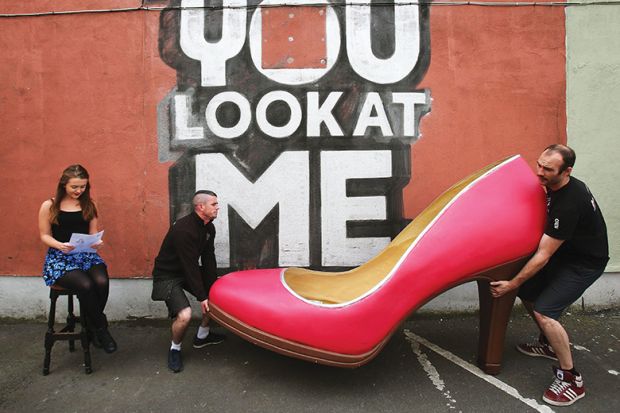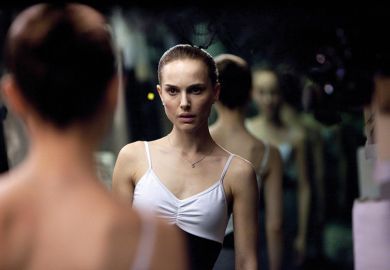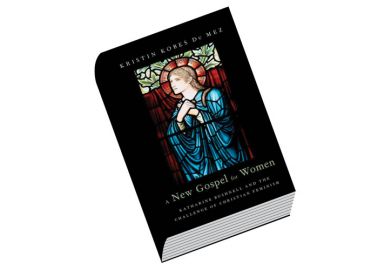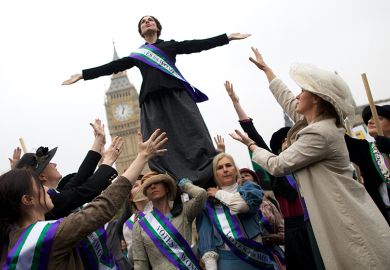When I was a little girl, I spent a lot of time drawing princesses and witches. Now that I’m an adult, it’s the witchy aesthetic that persists (I last wore pink in 1972), but I remember the princess drawings vividly. She would always be white, with long blonde hair, and she’d be wearing an unfeasibly – physics-defying – voluminous skirt. She would also have a waist so absurdly cinched-in that she would have immediately folded in two like a flaccid hyacinth had she stepped off the page. The stepping would have been tricky, too, since her clunky shoes invariably pointed directly left and right, in a ballet dancer’s second position.
Social historian Carol Dyhouse includes just such a picture in the afterword to her enjoyable new book, Love Lives: From Cinderella to Frozen. Although she drew hers in the 1950s and I drew mine some 20 years later, the similarities are striking: two little British girls separated by two decades had each absorbed and imitated an outrageously distorted and utterly pervasive cultural notion.
In Love Lives, Dyhouse develops the themes she established in her previous book, Heartthrobs: A History of Women and Desire, where she looked at “women as desiring subjects…in a wage-earning, consumer society”. The books share preoccupations and draw on similar sources – literature, film and pop culture – by way of illustration. The books’ covers, too, echo one another – a couple poised on the cusp of a snog. Love Lives doesn’t significantly advance the themes of Heartthrobs so much as reaffirm them in a well-written and informed way; it’s a familiar narrative repackaged and entertainingly told.
The chronological structure of Love Lives is tidy, bookended by the 1950 film version of Cinderella at its start and Frozen (2013) at the end. Dyhouse’s main goal is to consider how post-war social and cultural shifts changed all aspects of women’s lives, particularly their romantic and sexual aspirations. Whereas “Cinderella’s life was transformed when she met her prince” and “a man was an ending”, now “you’d be hard pushed to believe in girlhood innocence followed by the ineffably happy-ever-after”. Even so, Dyhouse contends, the traditional white wedding retains a cultural power that shows no signs of abating. I was staggered and not a little appalled to read: “In the UK, the average cost of a wedding reached an all-time high in 2017 at around £33,000.”
Dyhouse readily acknowledges the almost exclusively heterosexual British and North American focus of Love Lives, and she gleefully loots both cultures for examples and illustrations from a wide range of sources. My favourite, reproduced in the book, is a bizarre 1946 print advert for Shell: a white woman wearing a pencil skirt and matching jacket, and sporting a pillbox hat and stylish clutch bag, who steps out of a pumpkin coach above the caption “Cinderella and the Molecule”. Dyhouse does an excellent job of demonstrating how daydreams of Prince Charming provided, in the 1940s, a perfect antidote to post-war austerity, and reads the Queen’s wedding in 1947 as another iteration of the fairy tale. Even before Disney’s cartoon came along in 1950, then, girls “could scarcely escape the Cinderella story, which suffused popular culture and exemplified the dominant romantic narrative of the time”.
Disney’s princesses have evolved since Cinderella, and it’s a progression that Dyhouse shows has kept in step with key cultural shifts since the Second World War. “Little girls dressing up like princesses,” she writes, “don’t always fantasize about princes.” This remains very much an observation made in passing, however, and there were several points where I would have loved the author to have queered the canon far more than she does.
What she does do – and does well – is provide a witty cultural history of heterosexual courtship and sexual mores in the second half of the 20th century with some lively material from the UK. I particularly warmed to her analysis of accounts drawn from participants in the Mass Observation Project. Here are voices that, confident in their anonymity, tell it how it is, and Dyhouse is a sensitive and perceptive reader of these testimonies. In 1991, for example, participants invited to reflect on feminism conjured up “crude, unflattering stereotypes very similar to those rehearsed in the anti-suffragist literature of the 1900s”, despite many of them implicitly indicating how much the lives of young people – certainly in terms of reproductive autonomy and relationships – were better than their own had been. Dyhouse is very good at sharing occasionally jaw-dropping moments (“‘I didn’t even know I had a clitorus [sic] until I was over 46 years old’”) but has a tendency to let them speak for themselves, and could have pushed the analysis more.
Her work on TV and film – Bridget Jones’s Diary, Sex and the City and Friends – revisits well-trodden ground, but, like the rest of Love Lives, is clearly and entertainingly written. Dyhouse draws productive connections between American novelist Rona Jaffe’s The Best of Everything (1958) and these modern visual texts. All the protagonists are preoccupied with careers and intimate relationships but, in the novel, “You only became a ‘career girl’ if you failed to secure a fiancé” and sex is “fraught with danger for young women”. By the 1990s and 2000s, work and sex are still “primary aspects of experience and concern”, but – perhaps unsurprisingly – are “treated more lightly and casually”.
Love Lives isn’t trying to be a heavily theoretical book – and it’ll probably gain more market traction for precisely that reason. Kimberlé Crenshaw’s work on intersectionality is dispensed with in just half a dozen lines, and Judith Butler’s Gender Trouble gets half that. Dyhouse is pretty astute in describing feminism in the 1990s as having “descended into sometimes abstrusely theoretical academic in-fighting”. It does feel, however, as though in providing what amounts to a potted history of feminist waves, she loses sight of the book’s trajectory and through line. The section concludes with the commendable, if familiar, idea that “feminism cannot any longer be seen as a body of theory which belongs mainly in the academy, to be argued over by academics”. In her appraisal of Betty Friedan’s pioneering feminist work, The Feminine Mystique (1963), Dyhouse comes up with a phrase that inadvertently encapsulates my feelings about Love Lives: “the book was not always as radical as she herself would have had it, [but] her insights were conveyed with verve and style”.
I have a confession to make. I have never seen Frozen. I’ve heard of Elsa, of course, and know about her exhortation to “let it go”, but I don’t know what “it” is. Dyhouse’s infelicitous choice of words in describing how Elsa “lets rip with her ice magic” made me giggle (this is why I’ll always be more witch than princess). Yet she also writes that “the patriarchal figures in the story are mostly decrepit, vain, and ineffectual”. I already watch CNN and Newsnight and see much the same story, so Frozen is probably worth a look.
Emma Rees is professor of literature and gender studies at the University of Chester, where she is director of the Institute of Gender Studies.
Love Lives: From Cinderella to Frozen
By Carol Dyhouse
Oxford University Press, 288pp, £20.00
ISBN 9780198855460
Published 11 February 2021
The author
Carol Dyhouse, emeritus professor of history at the University of Sussex, was born in Birmingham and attended a state grammar school run by a “scholarly and high-minded” Oxford-educated headmistress, she recalls, where “girls were discouraged from caring about fashion and appearance. For a long time, even her staff were forbidden to wear lipstick.”
After a first degree in history at the University of Reading, where the curriculum was “stronger perhaps in Anglo-Saxon and early English history than in the modern period”, Dyhouse went on to do an MA in modern social history at Lancaster University. She wrote about the history of women’s education and then published Glamour: Women, History, Feminism (2010), which she describes as “a bit of a reaction against my school years and also the kind of feminism which frowned upon fashion and appearances”, leading a colleague to comment: “So it’s out of the bluestockings and into the fishnets, is it, Carol?” Along with material culture, however, she is equally interested in “the changing pattern of women’s dreams, desires and aspirations”. This found expression in both Heartthrobs: A History of Women and Desire (2017), which explores “how men have been the object of the female gaze”, and now Love Lives.
Asked about the changing significance of the Cinderella story, Dyhouse notes that, in post-war Britain, it “encouraged young women to dream about finding Mr Right, representing this as the key to happiness…because finding the right man was supposed to solve your life. These days, women’s education encourages more autonomy and independence. Young women may still seek romance – don’t we all? – but in reality, falling in love isn’t guaranteed to be a once-in-a-lifetime experience, and a loving relationship is more helpfully thought of as a staging post on a journey rather than a happy-ever-after.”
Matthew Reisz
Register to continue
Why register?
- Registration is free and only takes a moment
- Once registered, you can read 3 articles a month
- Sign up for our newsletter
Subscribe
Or subscribe for unlimited access to:
- Unlimited access to news, views, insights & reviews
- Digital editions
- Digital access to THE’s university and college rankings analysis
Already registered or a current subscriber?








